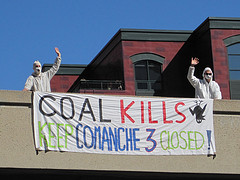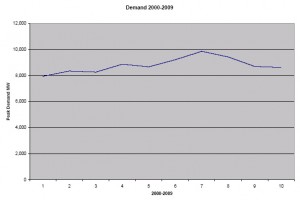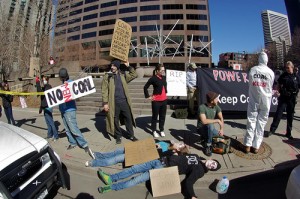Xcel – say it ain’t April Fools
April 2nd, 2010
From our friends in Colorado with this note:
A full copy of the spoof letter and press release are available at: www.xcelresponsiblebynature.com
(Website taken down on April 1, 2010 after complaint from Xcel…)
April 1, 2010
Denver, CO – On April Fools’ Day – as part of the international ‘Fossil Fools Day’ – Colorado activists pulled an elaborate prank on Xcel Energy, the largest utility company in the state. With a farce website (www.xcelresponsiblebynature.com), a satirical press release, and a letter to Colorado ratepayers, activists helped Xcel Energy become a renewable energy leader. The announcement said that Xcel Energy would switch to 100% renewable electricity in Colorado by phasing out all coal plants and abandoning plans to convert existing coal plants to natural gas.
In the spoof initiative, Xcel Energy agreed to pay for the transition to renewable energy out of its own deep pockets. The letter assured Colorado ratepayers: “While, over the past several years, we have raised rates for our customers numerous times, our new approach will put the burden on Xcel’s executives rather than our loyal and hardworking customers. And, rest assured, we can afford it. With an annual profit of nearly $700 million and CEO pay in the millions each year, our ‘responsible by nature’ executives are volunteering to take pay cuts to ensure the success of our plan.”
The press release was sent to a wide variety of media outlets, including business and financial journals around the country. In addition, the press release was sent to politicians and public agencies throughout Colorado, as well as to to various fossil fools, including coal and gas companies and lobby groups such as Americans for Clean Coal Electricity, to remind them which way the wind is blowing.
Beyond that, activists throughout the state distributed thousands of copies of a “letter from Xcel” to ratepayers and renewable energy companies, who were encouraged to email Xcel Energy’s Board of Directors to thank them for their “bold renewable energy proposal.”
The press release was sent out by “Simon Grunwasch.” Grunwasch is German for “greenwash,” indicating that Xcel Energy is masking its environmentally destructive reliance on fossil fuels behind a public image that emphasizes renewable energy. Currently, 90% of the company’s electricity in Colorado is generated by fossil fuels and only 10% from renewable sources. However, this is not for a lack of wind, solar and geothermal capacity. Xcel has received 15,000MW of bids for renewable energy projects – more than double its peak demand – but has only accepted a small fraction.
Though the company has recently announced its support of legislation that would retire or modify three Front Range coal plants by 2017, it is simultaneously opening the Comanche 3 coal-fired power plant in Pueblo – the largest coal plant in the state. The lifetime emissions from operating Comanche 3 will overwhelm any savings from retiring Front Range coal plants a few years early. Worse still, these coal plants could be replaced with natural gas, which still emits roughly 60% as much CO2 as coal, in addition to methane – a highly potent greenhouse gas.
“While this spoof announcement is unfortunately nothing more than an April Fools’ Day joke, it is an honest representation of what Xcel Energy needs to do,” said ‘Simon Grunwasch.’ “Xcel Energy needs to stop raising rates on Coloradans to pay for new coal plants, expensive natural gas and perks for their executives. Instead, they need to invest their vast resources in renewable energy for Colorado.”
More information about Fossil Fools Day is available at: Fossilfoolsdayofaction.org
Wish it were true? Contact Xcel Energy’s Board of Directors at: boardofdirectors@xcelenergy.com
Xcel’s 10-K and a die-in!
February 26th, 2010
***********************************************
I just got a tip on what looks like a great book:
The Grid: A Journey Through the Heart of Our Electrified World
***********************************************
XCEL’s 2009 10-K just came out, and demand is down, down from 2008, but unfortunately not all that much… maybe next year!
And that, folks, is Xcel’s peak demand, from 2000 through 2009.
Now, if someone will only tell me how to label the X axis… I cannot figure it out. “1” is 2000, “2” is 2001, etc…
And about that die-in, hot off the “press” from Ted Nace:
Local Citizens ‘Die-in’ at Xcel HQ in Coal Protest
Group calls on Xcel to Keep Comanche 3 Closed and Produce 100% Renewable Electricity by 2020
February 26, 2010
Denver, CO – At 11:45am on Friday, February 26th, local citizens demonstrated at the Denver headquarters of Xcel Energy – located at the corner of 17th St. and Lawrence St. – in protest of the utility’s impending plan to bring a new coal-fired power plant online in Pueblo, CO. The lunch hour protest called on Xcel executives to move Colorado in the right direction by keeping the Comanche 3 coal-fired power plant closed. Protestors demonstrated in a ‘die-in’ in front of the building’s main entrance to highlight the grim consequences that coal has on our lives and those of future generations. Simultaneously, two activists clad in hazmat suits dropped a banner off an adjoining bridge on Lawrence St. Police arrived on scene but no arrests were made.
The 750-megawatt Comanche Unit 3 would be the largest coal-fired power plant in the state, surpassing even the mammoth Cherokee coal plant in North Denver. “At a time when the costs of coal are becoming increasingly clear and the benefits of clean energy are ever more apparent, building the largest coal-fired power plant in the state is taking us 180 degrees in the wrong direction,” said Amy Guinan, an activist with Power Past Coal.
According to Xcel’s own data, the Comanche 3 plant would emit over 20 million pounds of CO2 a day, 2 pounds of mercury a week and thousands of tons of particulates and haze forming pollutants every year. The plant would also consume over 4 million gallons of water a day.
“Xcel has already wasted nearly $1 billion on this planet-destroying boondoggle. Operating it could cost ratepayers billions more. For the sake of Colorado’s children, and future generations, it is time for Xcel to pull the plug on this ill-conceived coal plant and redirect their investments towards making Colorado 100% renewable,” said Tom Weis, President of Wind Power Solutions.
Xcel has had ongoing problems bringing the plant online. While Xcel originally hoped to bring the plant into operation last fall, a variety of technical problems – currently involving a boiler pump – continue to push back its scheduled opening.“There are a lot more than just technical problems with this new coal-fired power plant. There are serious social, economic and environmental problems. Rather than talking about a delayed opening, we should be talking about a permanent closure. Instead of building a new coal-fired plant, Xcel should be investing heavily in Colorado’s abundant solar and wind resources,” said Brian Bernhardt, an activist with Power Past Coal.
Today’s protest is part of an ongoing series of actions to move Colorado beyond coal. Sparked by the failure of elected and appointed officials to take meaningful action to move rapidly to renewable energy, the Power Past Coal campaign is building a grassroots protest effort. With the Colorado Department of Public Health and Environment approving the permit-to-pollute for both the Valmont and Cherokee stations despite overwhelming public opposition, citizens are prepared to ramp up the pressure on Xcel executives, as well as Colorado politicians and regulatory agencies.
“Our leaders are failing to lead and Xcel is failing to take their responsibility seriously. Xcel should expect more protests and actions unless they start closing down coal plants and moving Colorado to 100% renewable electricity,” Kate Clark, a Power Past Coal activist.
Xcel has been challenged on multiple fronts this week. On Tuesday evening, Pueblo residents – where the new coal-fired power plant is built – raised serious concerns about high-pitched noises from the plant which are affecting people as far as nine miles away. Meanwhile, WildEarth Guardians petitioned the U.S. Environmental Protection Agency to protect clean air and the climate and overturn an air pollution permit allowing Xcel Energy to illegally pollute while operating the Pawnee coal-fired power plant.
Closing coal plants and lack of need in PJM
December 4th, 2009
We all know “need” for electricity is down, down, down:
Take a few minutes and scan that report — it’s telling it like it is. Prices down 40+ % and demand down at least 4+% this year so far (that’s what they’ll admit to, and I figure it’s a lot worse than that!).
Decreased demand was a reason for cutting out the Indian River – Salem part of the MAPP line…
HOT OFF THE PRESS, decreased demand is the reason coal plants are being shut down in Pennsylvania, FOUR coal plants in Pennsylvania:
Exelon to close 4 Penn. generating units by 2011
Alan says that the Eddystone ones are a couple of the first supercritical coal plants around, they’ve been running for ages. But that they’d close down the coal and keep oil-burning units? What gives? Peaking power? Or??? Doesn’t make sense to me. It doesn’t get much dirtier than burning fuel oil. Those have to go too…
Baltimore: Rally on Tuesday — say NO to transmission for coal!
November 29th, 2009
It’s so good to be home … for a second or so, that is, before the CapX 2020 Brookings public and evidentiary hearings start. For more on that, go to NoCapX 2020!
PJM’s Mid-Atlantic Power Pathway is in the news again… or is it PEPCO… or is it Delmarva Power… yes, another stupid transmission idea comin’ down the pike… it’s time to say NO! to transmission for coal!
Join the “No New Coal” brigade at the rally:
Baltimore’s Preston Gardens Park
Don’t get confused by this map of MAPP — they’re now admitting that the part from Indian River to Salem “isn’t needed” and it’s only a matter of time before they figure out that a 500kV line to nowhere isn’t needed either.

From The Diamondback, the University of Maryland’s paper – YES! maybe there’s hope, maybe they’ll do a better job than we have:
MAPP and PATH: Time to draw the line
Are people starting to get it? Here’s another from the Diamondback:
Guest column: Toppling King Coal
Krishna Amin is a junior biochemistry major. She can be reached at krish121 at umd dot edu.
Big Stone is dead, dead, dead
November 2nd, 2009
Hot off the press from MDU — there’s contact info at the bottom.
DO SEND THEM CONDOLENCES AND A THANK YOU NOTE!!!
From MPR just now:
And a BSII Press Release found in the inbox:
November 2, 2009
Participating utilities announce wind-down of Big Stone II project
The participating utilities announced today that they will not build the Big Stone II Project, a planned 500-to-600-megawatt coal-fired power plant to be located near Milbank, South Dakota, and its associated transmission. The project required additional participants to move forward; however none have committed.
Big Stone II, a fully permitted project, had been determined to be the least-cost, environmentally sound baseload power plant for the project participants. The project’s high voltage transmission facilities were to be sized to also serve the region’s burgeoning wind energy development.
The Big Stone II Project participants were Central Minnesota Municipal Power Agency, Heartland Consumers Power District, Missouri River Energy Services and Montana-Dakota Utilities Co.
For information specific to each company, contact:
Mark Hanson, Montana-Dakota Utilities Co., 701-530-1093 or mark.hanson@mduresources.com.
Bill Radio, Missouri River Energy Services, 605-731-2522 or billr@mrenergy.com.
Russ Olson, Heartland Consumers Power District, 605-256-6536 or rolson@hcpd.com.
Lori Frisk-Thompson, Central Minnesota Municipal Power Agency, 507-526-2193 or lorift@cmmpa.org.






